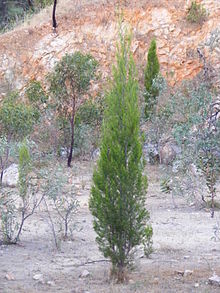
Summary
Callitris preissii is a species of conifer in the family Cupressaceae, endemic to Rottnest Island, Australia. Common names include Rottnest Island pine, Murray pine, maroong, southern cypress pine, and slender cypress pine. The Noongar peoples know the tree as marro.[3]
| Callitris preissii | |
|---|---|

| |
| Callitris preissii sapling in Adelaide, South Australia | |
| Scientific classification | |
| Kingdom: | Plantae |
| Clade: | Tracheophytes |
| Clade: | Gymnospermae |
| Division: | Pinophyta |
| Class: | Pinopsida |
| Order: | Cupressales |
| Family: | Cupressaceae |
| Genus: | Callitris |
| Species: | C. preissii
|
| Binomial name | |
| Callitris preissii | |
| Synonyms[2] | |
| |
Description edit
The pine can have a tree or shrub-like habit typically growing to a height of 1 to 9 metres (3 to 30 ft) and a width of up to 6 metres (20 ft).[4] It is relatively slow growing. The crown is commonly made up fine, dense foliage.[5] The leaf is rounded on the dorsal side and the cones often have a width of over 2 centimetres (0.8 in) with scales that do not separate from the base. It starts producing brown-yellow-orange cones between October and January.[4] The root system is generally moderate to deep or shallow and spreading. It is reasonably long lived, usually to over 15 years of age.[5]
Distribution edit
It is endemic to the Swan Coastal Plain, Rottnest Island and Garden Island[5] but has become naturalised elsewhere and now has a scattered distribution throughout the Mid West, Wheatbelt, Peel, Great Southern and Goldfields-Esperance regions where it is found on plains, slopes, the margins of salt lakes and among granite outcrops growing in sandy, loamy or clay soils.[4]
Uses edit
The plant makes a good windbreak or as a shelterbelt or shade for stock. The trunks make ideal fence posts and it has good ornamental attributes. The plant's pollen has value for apiculture. In urban areas it makes a good ornamental plant, or as a free street tree and is suitable as a screen or hedge.
References edit
- ^ Thomas, P. (2013). "Callitris preissii". IUCN Red List of Threatened Species. 2013: e.T42207A2961510. doi:10.2305/IUCN.UK.2013-1.RLTS.T42207A2961510.en. Retrieved 15 November 2021.
- ^ The Plant List: A Working List of All Plant Species, retrieved 27 February 2017
- ^ "Noongar names for plants". kippleonline.net. Archived from the original on 2016-11-20. Retrieved 24 November 2016.
- ^ a b c "Callitris preissii". FloraBase. Western Australian Government Department of Biodiversity, Conservation and Attractions.
- ^ a b c "Callitris preissii". Fact Sheet. FloraBank. Retrieved 13 October 2018.



